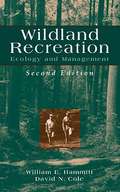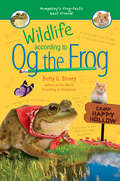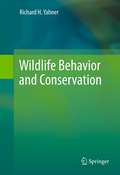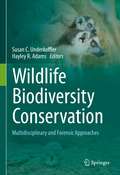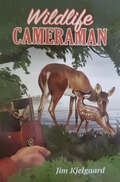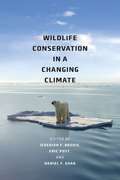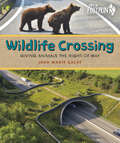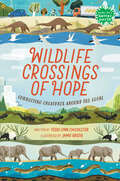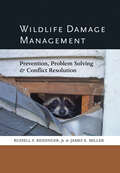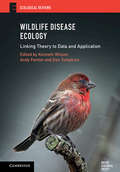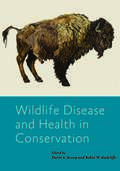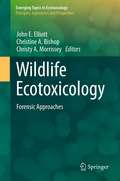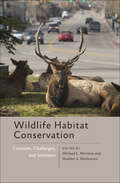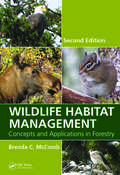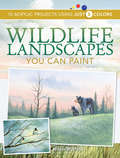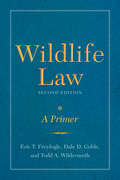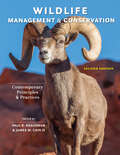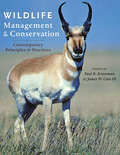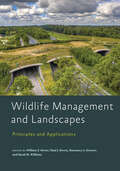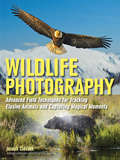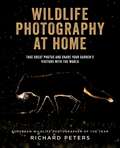- Table View
- List View
Wildland Recreation: Ecology and Management (2nd Edition)
by William E. Hammitt David N. ColeAn authoritative guide to managing the ecological impacts of recreational activities on natural resources. The challenges facing today's recreation resource managers are both complex and daunting. Accommodating rapidly growing numbers of recreational visitors without sacrificing the ecological integrity of wildlands is a major challenge. Determining and planning for the limits of acceptable change and expanding services with little or no growth in natural resources or funding are major issues. Wildland Recreation, Second Edition provides solutions to these and other crucial recreational resource problems. Based upon its authors' extensive firsthand experience as well as their exhaustive review of the world literature on the subject, it provides up-to-date, detailed coverage of today's wildland recreation management issues, including: * Ecological impacts of recreational activities on wildland resources * Spatial and temporal patterns of recreational impacts * Environmental durability, visitor use, and other key factors * The limits of acceptable change, long-term monitoring, and impacts on wildlife * Social and economic factors associated with managing impacts * Alternative approaches to wildland recreation resource management * Recent trends in satisfying increased demand for outdoor recreational opportunities * International perspectives on recreational wildland management and ecotourism Like its best-selling predecessor, Wildland Recreation, Second Edition is a valuable working resource for wildland recreation management professionals and a comprehensive course text for students of forest and natural resources recreation, park management, environmental conservation, and related disciplines.
Wildlife According to Og the Frog (Og the Frog #3)
by Betty G. BirneyIn the third book in the spinoff of the Humphrey series, Og and Humphrey head to summer camp to see what's hopping in the wilderness!Og didn't know where he would end up when school was over, but it turns out Camp Happy Hollow is just about the best place ever. Lovely nature is all around, friends from Room 26 are there--including Humphrey!--and camp days are full of exciting activities. Og has lots of new responsibilities, like watching out for Humphrey, helping his fellow campers adjust to being away from home, and encouraging everyone to always try their best. But when one camper lets Og loose at the lake, he is in a tough spot. The lake sure does feel like home, but so does his tank. Plus his human friends need him--and so does Humphrey. Good thing Og has experience in the wild because--BING-BANG-BOING!--this is going to be one hopping summer! Og's frog's-eye view of summer camp is silly, caring, and adventurous--the perfect companion to Summer According to Humphrey.
Wildlife Behavior and Conservation
by Richard H. YahnerBegins with in-depth coverage of wildlife behavior concepts as they relate to conservation problems. Topics will focus principally on discussion, critique, and development of behavioral concepts, with particular attention given to published studies on various topics in wildlife behavioral concepts as related to conservation and natural history. He will include an extensive list of references.
Wildlife Biodiversity Conservation: Multidisciplinary and Forensic Approaches
by Susan C. Underkoffler Hayley R. AdamsThis book addresses the multidisciplinary challenges in biodiversity conservation with a focus on wildlife crime and how forensic tools can be applied to protect species and preserve ecosystems. Illustrated by numerous case studies covering different geographical regions and species the book introduces to the fundamentals of biodiversity conflicts, outlines the unique challenges of wildlife crime scenes and reviews latest techniques in environmental forensics, such as DNA metagenomics. In addition, the volume explores the socio-economic perspective of biodiversity protection and provides an overview of national and international conservation laws. The field of conservation medicine stresses the importance of recognizing that human health, animal health, and ecosystem health are inextricably interdependent and the book serves as important contribution towards achieving the UN Sustainable Developmental Goals, in particular SDG 15, Life on Land. The book addresses graduate students, scientists and veterinary professionals working in wildlife research and conservation biology.
Wildlife Cameraman
by Jim KjelgaardYoung Jase Mason’s ambition was to be a wildlife photographer. To find out whether or not he had real ability, he spent a summer in the wilderness with his dog and his cameras. It was a summer filled with adventure. Living close to nature, boy and dog both learned a great deal about wilderness dwellers, from rabbits to bears and moose. They also became unexpectedly involved with game wardens and poachers. Through it all, Jase stubbornly stuck to his ambition to become a wildlife cameraman. Author of a score of fine books about the outdoors, Jim Kjelgaard here combines his mastery of open-air adventure with a story of youthful determination and hard work in the face of obstacles. He also shows how nature maintains its own balance among living things, and how man can maintain or upset that balance by his attitude toward conservation
Wildlife Conservation in a Changing Climate
by Jedediah F. Brodie, Eric Post, and Daniel F. DoakHuman-induced climate change is emerging as one of the gravest threats to biodiversity in history, and while a vast amount of literature on the ecological impact of climate change exists, very little has been dedicated to the management of wildlife populations and communities in the wake of unprecedented habitat changes. Wildlife Conservation in a Changing Climate is an essential resource, bringing together leaders in the fields of climate change ecology, wildlife population dynamics, and environmental policy to examine the impacts of climate change on populations of terrestrial vertebrates. Chapters assess the details of climate change ecology, including demographic implications for individual populations, evolutionary responses, impacts on movement patterns, alterations of species interactions, and predicting impacts across regions. The contributors also present a number of strategies by which conservationists and wildlife managers can counter or mitigate the impacts of climate change as well as increase the resilience of wildlife populations to such changes. A seminal contribution to the fields of ecology and conservation biology, Wildlife Conservation in a Changing Climate will serve as the spark that ignites a new direction of discussions about and action on the ecology and conservation of wildlife in a changing climate.
Wildlife Crossing: Giving Animals the Right-of-Way (Orca Footprints #32)
by Joan Marie GalatWhat happens when the needs of people and nature collide? More than 13 million miles of roads crisscross landscapes in 222 countries. Roads offer many human benefits, but they also create problems for nature. Their construction leads to a loss of biodiversity through habitat loss, fragmentation and degradation. Roads isolate wildlife populations, impede migration and allow invasive plant and animal species to spread, while giving rise to pollution from garbage, light, noise and airborne contaminants. With innovative tools, like wildlife overpasses to reconnect landscapes, smart roads and vehicles to maximize safety, and a little hands on help, we can create environmental harmony. And sitting in the passenger seat, young people can play a part in helping highways and habitats coexist. The epub edition of this title is fully accessible.
Wildlife Crossings of Hope: Connecting Creatures Around the Globe (Books for a Better Earth)
by Teddi Lynn ChichesterWe all need safe places to live and safe paths to travel. Animals, too.Meet the people who are stitching the planet's habitats back together.Let&’s explore together how scientists, engineers, and lots of everyday people are working to make sure that the wildlife so essential to Earth&’s health and beauty continues to freely move through the landscapes, waterways, and skylines of this richly inhabited planet. Combining first-person reporting with research and stunning two-color art from illustrator Jamie Green, Wildlife Crossings of Hope takes a personal, in-depth look at wildlife crossings, corridor projects, and dam removal efforts around the world, from an underpass for elephants in Kenya to the Un-Dam the Klamath movement in the U.S. to the Mesoamerican Biological Corridor, which extends from southern Mexico to Panama. Above all, this is a book that invites young people to think of themselves and wildlife as part of one community that urgently needs restoration and protection. Back matter includes actions for kids to take, a complete listing of the scientific names of all creatures discussed, source notes, a bibliography, an index, and more. Books for a Better Earth™ are designed to inspire children to become active, knowledgeable participants in caring for the planet they live on.A Junior Library Guild Gold Standard Selection
Wildlife Damage Management: Prevention, Problem Solving, and Conflict Resolution
by James E. Miller Russell F. Reidinger Jr.A complete guide to preventing and resolving problems associated with wildlife-human interactions.Whether you are a student in a wildlife degree program or a professional wildlife biologist, you will find all the up-to-date information on wildlife damage in the pages of this clear, comprehensive text. Wildlife Damage Management covers every imaginable topic including:• pertinent biological and ecological concepts• individual-, population-, and ecosystem-level effects• survey techniques• management methods• human dimensions• economic issues• legal and political aspects• damage management strategiesAuthors Russell F. Reidinger, Jr., and James E. Miller explain the evolution of wildlife damage management, differentiate facts from myths, and detail the principles and techniques a professional biologist needs to know. The book discusses native as well as exotic invasive species, zoonotic diseases, hazards to endangered or threatened fauna and flora, and damage to crops, livestock, and property. Reidinger and Miller argue that, in recent years, the rate of undesirable human-wildlife interactions has risen in many areas, owing in part to the expansion of residences into places formerly wild or agricultural, making wildlife damage management even more relevant.From suburban deer eating gardens and shrubs, to mountain lions threatening pets and people, to accidentally introduced species outcompeting native species, Reidinger and Miller show how proper management can reduce wildlife damage to an acceptable, cost-effective level. An extensive section on available resources, a glossary that explains terms and concepts, and detailed figures will aid both students and seasoned professionals. Instructors will find this text arranged perfectly for a semester-long course. The end-of-chapter questions will allow students to ponder the ways wildlife damage management concepts can be put into practice. For those already working in the field—biologists and managers with federal, state, or international agencies—Wildlife Damage Management will serve as an ideal reference book. Destined to set the tone of wildlife damage conversations for the next decade and beyond, Reidinger and Miller belongs on the shelf of all wildlife professionals.
Wildlife Disease Ecology: Linking Theory to Data and Application (Ecological Reviews)
by Kenneth Wilson Andy Fenton Dan TompkinsJust like humans, animals and plants suffer from infectious diseases, which can critically threaten biodiversity. This book describes key studies that have driven our understanding of the ecology and evolution of wildlife diseases. Each chapter introduces the host and disease, and explains how that system has aided our general understanding of the evolution and spread of wildlife diseases, through the development and testing of important epidemiological and evolutionary theories. Questions addressed include: How do hosts and parasites co-evolve? What determines how fast a disease spreads through a population? How do co-infecting parasites interact? Why do hosts vary in parasite burden? Which factors determine parasite virulence and host resistance? How do parasites influence the spread of invasive species? How do we control infectious diseases in wildlife? This book will provide a valuable introduction to students new to the topic, and novel insights to researchers, professionals and policymakers working in the field.
Wildlife Disease and Health in Conservation (Wildlife Management And Conservation Ser.)
by David A. Jessup and Robin W. RadcliffeWildlife Ecology And Management
by Eric G. Bolen William Laughlin RobinsonThis exceptionally comprehensive, single-source introduction to the art, science, theories, practices, and issues of wildlife management is ideal for the novice in the subject. Features full-chapters on predators, urban wildlife, policy, water, soil, diseases, conservation biology. New, up-to-date issues covered include the removal of dams, global warming, emerging diseases among elk and deer, adaptive harvest management, animal rights groups, women hunters, population data, migratory animals and more. For anyone interested in an exceptionally comprehensive introduction to wildlife management and conservation.
Wildlife Ecotoxicology
by Christine A. Bishop John E. Elliott Christy MorrisseyMany books have now been published in the broad field of environmental toxicology. However, to date, none of have presented the often fascinating stories of the wildlife science, and the steps along the way from discovery of problems caused by environmental pollutants to the regulatory and non-regulatory efforts to address the problems. This book provides case by case examinations of how toxic chemical effects on wildlife have brought about policy and regulatory decisions, and positive changes in environmental conditions. Wild animal stories, whether they are about the disappearance of charismatic top predators, or of grossly deformed embryos or frogs, provide powerful symbols that can and have captured the public's imagination and have resulted in increased awareness by decision makers. It is the intent of this book to present factual and balanced overviews and summaries of the science and the subsequent regulatory processes that followed to effect change (or not). We cover a variety of chemicals and topics beginning with an update of the classic California coastal DDT story of eggshell thinning and avian reproduction to more recent cases, such as the veterinarian pharmaceutical that has brought three species of Asian vultures to the brink of extinction. Researchers, regulators, educators, NGOs and the general public will find valuable insights into the processes and mechanisms involved both in environmental scientific investigation and in efforts to effect positive change.
Wildlife Habitat Conservation: Concepts, Challenges, and Solutions (Wildlife Management and Conservation)
by Heather A. Mathewson and Michael L. MorrisonA book that emphasized the concept of wildlife habitat for a generation of students and professionals is now available to even more readers."Habitat" is probably the most common term in ecological research. Elementary school students are introduced to the term, college students study the concept in depth, hunters make their plans based on it, nature explorers chat about the different types, and land managers spend enormous time and money modifying and restoring habitats. Although a broad swath of people now have some notion of what habitat is, the scientific community has by and large failed to define it concretely, despite repeated attempts in the literature to come to meaningful conclusions regarding what habitat is and how we should study, manipulate, and ultimately conserve it.Wildlife Habitat Conservation presents an authoritative review of the habitat concept, provides a scientifically rigorous definition, and emphasizes how we must focus on those critical factors contained within what we call habitat. The result is a habitat concept that promises long-term persistence of animal populations. Key concepts and items in the book include:• Rigorous and standard conceptual definitions of wildlife and their habitat.• A discussion of the essential integration of population demographics and population persistence with the concept of habitat.• The importance of carryover and lag effects, behavioral processes, genetics, and species interactions to our understanding of habitat. • An examination of spatiotemporal heterogeneity, realized through fragmentation, disruption to eco-evolutionary processes, and alterations to plant and animal assemblages.• An explanation of how anthropogenic effects alter population size and distribution (isolation), genetic processes, and species diversity (including exotic plants and animals).• Advocacy of proactive management and conservation through predictive modeling, restoration, and monitoring.Each chapter is accessibly written in a style that will be welcomed by private landowners and public resource managers at local, state, and federal levels. Also ideal for undergraduate and graduate natural resource and conservation courses, the book is organized perfectly for a one-semester class.Published in association with The Wildlife Society.
Wildlife Habitat Management: Concepts and Applications in Forestry, Second Edition
by Brenda C. McCombShortlisted for the 2018 TWS Wildlife Publication Awards in the authored book categoryIn recent years, conflicts between ecological conservation and economic growth forced a reassessment of the motivations and goals of wildlife and forestry management. Focus shifted from game and commodity management to biodiversity conservation and ecological fore
Wildlife Landscapes You Can Paint: 10 Acrylic Projects Using Just 5 Colors
by Wilson BickfordCapture the beauty and serenity of animals in natureIf you love nature and life's simpler things, you'll love painting with Wilson Bickford. In this book, with a teaching style as easy and inviting as his paintings, Wilson guides you step by step through ten charming wildlife scenes on canvas.Projects feature a variety of beloved animals including deer, black bears, blue herons, loons, ducks, swans and woodpeckersLearn to paint a range of breathtaking settings - sparkling lakes, majestic mountains, forest retreats and even atmospheric effects like hazy sunsets, snow-laden pines and rippling water.Includes mini-demonstrations that focus on key landscape elements such as trees, rocks, water and clouds.Each project includes color swatches showing which mix is used where and easy-to-follow directions.Simpler is always better when you're just starting out. These projects require minimal equipment, only five colors and absolutely no previous experience. Wilson loves to paint them - and with his friendly, straightforward approach, you will, too!
Wildlife Law, Second Edition: A Primer
by Eric T. Freyfogle Dale D. Goble Dr Todd A. WildermuthWildlife is an important and cherished element of our natural heritage in the United States. But state and federal laws governing the ways we interact with wildlife can be complex to interpret and apply. Ten years ago, Wildlife Law: A Primer was the first book to lucidly explain wildlife law for readers with little or no legal training who needed to understand its intricacies. Today, navigating this legal terrain is trickier than ever as habitat for wildlife shrinks, technology gives us new ways to seek out wildlife, and unwanted human-wildlife interactions occur more frequently, sometimes with alarming and tragic outcomes.This revised and expanded second edition retains key sections from the first edition, describing basic legal concepts while offering important updates that address recent legal topics. New chapters cover timely issues such as private wildlife reserves and game ranches, and the increased prominence of nuisance species as well as an expanded discussion of the Endangered Species Act, now more than 40 years old. Chapter sidebars showcase pertinent legal cases illustrating real-world application of the legal concepts covered in the main text.Accessibly written, this is an essential, groundbreaking reference for professors and students in natural resource and wildlife programs, land owners, and wildlife professionals.
Wildlife Management and Conservation: Contemporary Principles and Practices
by Paul R. Krausman And James W. Cain IIIThe definitive textbook for students of wildlife management, now updated to cover the latest techniques, tools, and topics.Wildlife Management and Conservation presents a clear overview of the management and conservation of animals, their habitats, and how people influence both. The relationship among these three components of wildlife management is explained in chapters written by leading experts and is designed to prepare students for careers in which they will be charged with maintaining healthy animal populations. To be successful wildlife professionals, they will need to find ways to restore depleted populations, reduce overabundant, introduced, or pest species, and manage relationships among various human stakeholders. This book gives them the basic knowledge necessary to accomplish these goals.This second edition, which is updated throughout, features several new and expanded topics, including communication in the wildlife profession, fire science, Indigenous models of management and conservation, plant–animal interactions, quantitative analysis of wildlife populations, and a detailed glossary. The book also covers:• Human dimensions of wildlife management• Animal behavior• Predator–prey relationships• Structured decision making• Issues of scale in wildlife management• Wildlife health• Historical context of wildlife management and conservation• Hunting and trapping• Nongame species• Nutrition ecology• Water management• Climate change• Conservation planningThe most widely used foundational text in the field, this is the perfect resource not only for students but also for early career professionals and those in related fields who need to understand the core tenets and tools of wildlife conservation and management.Contributors: C. Jane Anderson, Bart M. Ballard, Warren B. Ballard, John A. Bissonette, Clint Boal, Scott B. Boyle, Leonard A. Brennan, Robert D. Brown, James W. Cain III, Tyler A. Campbell, Michael J. Cherry, Michael R. Conover, Daniel J. Decker, Randall W. DeYoung, Jonathan B. Dinkins, W. Sue Fairbanks, Selma N. Glasscock, James B. Grand, Michael J. Haney, James R. Heffelfinger, Scott E. Henke, Fidel Hernandez, Davie G. Hewitt, C. L. Hoving, David A. Jessup, Heather E. Johnson, Winifred B. Kessler, John L. Koprowski, Paul R. Krausman, William P. Kuvlesky, Jr., Roel R. Lopez, R. W. Mannan, Scott Mills, Michael S. Mitchell, Michael L. Morrison, Anna M. Muñoz, John F. Organ, Katherine L. Parker, William F. Porter, Shawn J. Riley, Steven S. Rosenstock, Michael C. Runge, Susan P. Rupp, William F. Siemer, Robert J. Steidl, Kelley M. Stewart
Wildlife Management and Conservation: Contemporary Principles and Practices (Wildlife Management And Conservation Ser.)
by Paul R. Krausman James W. Cain IIIA definitive textbook for students of wildlife management.Wildlife Management and Conservation presents a clear overview of the management and conservation of animals, their habitats, and how people influence both. The relationship among these three components of wildlife management is explained in chapters written by leading experts and is designed to prepare wildlife students for careers in which they will be charged with maintaining healthy animal populations; finding ways to restore depleted populations while reducing overabundant, introduced, or pest species; and managing relationships among various human stakeholders.Topics covered in this book include• The definitions of wildlife and management• Human dimensions of wildlife management• Animal behavior• Predator–prey relationships • Structured decision making• Issues of scale in wildlife management• Wildlife health• Historical context of wildlife management and conservation• Hunting and trapping• Nongame species• Nutrition ecology• Water management• Climate change• Conservation planning
Wildlife Management and Landscapes: Principles and Applications (Wildlife Management and Conservation)
by William F. Porter, Chad J. Parent, Rosemary A. Stewart and David M. WilliamsWildlife management specialists and landscape ecologists offer a new perspective on the important intersection of these fields in the twenty-first century.It's been clear for decades that landscape-level patterns and processes, along with the tenets and tools of landscape ecology, are vitally important in understanding wildlife-habitat relationships and sustaining wildlife populations. Today, significant shifts in the spatial scale of extractive, agricultural, ranching, and urban land uses are upon us, making it more important than ever before to connect wildlife management and landscape ecology. Landscape ecologists must understand the constraints that wildlife managers face and be able to use that knowledge to translate their work into more practical applications. Wildlife managers, for their part, can benefit greatly from becoming comfortable with the vocabulary, conceptual processes, and perspectives of landscape ecologists.In Wildlife and Landscapes, the foremost landscape ecology experts and wildlife management specialists come together to discuss the emerging role of landscape concepts in habitat management. Their contributions• make the case that a landscape perspective is necessary to address management questions• translate concepts in landscape ecology to wildlife management• explain why studying some important habitat-wildlife relationships is still inherently difficult• explore the dynamic and heterogeneous structure of natural systems• reveal why factors such as soil, hydrology, fire, grazing, and timber harvest lead to uncertainty in management decisions• explain matching scale between population processes and management• discuss limitations to management across jurisdictional boundaries and balancing objectives of private landowners and management agencies• offer practical ideas for improving communication between professionals• outline the impediments that limit a full union of landscape ecology and wildlife managementUsing concrete examples of modern conservation challenges that range from oil and gas development to agriculture and urbanization, the volume posits that shifts in conservation funding from a hunter constituent base to other sources will bring a dramatic change in the way we manage wildlife. Explicating the foundational similarity of wildlife management and landscape ecology, Wildlife and Landscapes builds crucial bridges between theoretical and practical applications.Contributors: Jocelyn L. Aycrigg, Guillaume Bastille-Rousseau, Jon P. Beckmann, Joseph R. Bennett, William M. Block, Todd R. Bogenschutz, Teresa C. Cohn, John W. Connelly, Courtney J. Conway, Bridgett E. Costanzo, David D. Diamond, Karl A. Didier, Lee F. Elliott, Michael E. Estey, Lenore Fahrig, Cameron J. Fiss, Jacqueline L. Frair, Elsa M. Haubold, Fidel Hernández, Jodi A. Hilty, Joseph D. Holbrook, Cynthia A. Jacobson, Kevin M. Johnson, Jeffrey K. Keller, Jeffery L. Larkin, Kimberly A. Lisgo, Casey A. Lott, Amanda E. Martin, James A. Martin, Darin J. McNeil, Michael L. Morrison, Betsy E. Neely, Neal D. Niemuth, Chad J. Parent, Humberto L. Perotto-Baldivieso, Ronald D. Pritchert, Fiona K. A. Schmiegelow, Amanda L. Sesser, Gregory J. Soulliere, Leona K. Svancara, Stephen C. Torbit, Joseph A. Veech, Kerri T. Vierling, Greg Wathen, David M. Williams, Mark J. Witecha, John M. Yeiser
Wildlife Photography
by Joseph ClassenWildlife photography is an adventure--and as any great adventure story unfolds, odds are, there are bound to be some great risks involved. Whether it's the risk or the reward--or both--that motivates wildlife shooters, there is one pervasive truth: Preparation is key to success--and survival. In this book, Joe Classen approaches the art of wildlife photography from a hunter's perspective. He teaches readers how to select and use the appropriate specialized photographic gear required for the rigors of wildlife photography--as you'd expect. However, he also teaches you how to mentally and physically prepare for an outing in which your wits must be as keen as your eye. Classen provides detailed insights into planning and packing for a wilderness adventure. Readers will learn how to securely pack their delicate photographic gear for a rugged, outdoor environment but will also learn how to choose and tote the best clothing for the site, accessories to ensure your personal safety, and even basic cooking and drinking requirements for days spent shooting in remote areas. Once you've scouted your location, you'll learn how to track and lure your photographic subject using time-honored practices (calls--from lust to hunger, to anger and sloth; decoys; attractor scents; working invisibly, etc. ) while "shooting" (your camera!) from a blind or stand--or, conversely, by using a more aggressive stalk-and-ambush approach. You'll learn how to read animal behaviors--from eating to mating--and predict how, when, and where your best photographic opportunities will arise--and when your safety should be a greater concern than your shot. With this soup-to-nuts approach, readers will find, in this book, a compendium of information about wild-animal behavior, wilderness survival and safety, the art and science of photographic capture, and even storing and processing your prized digital files once you return home from your adventure. Armed with Classen's suggestions and strategies, you'll maximize your photo opportunities and increase the odds that your wildlife images are the mount-and-frame trophies for which yourisked life and limb.
Wildlife Photography
by Richard BernabeThere is nothing quite so satisfying as capturing a stunning wildlife photograph; a good one will reflect practice, patience, careful equipment choice and dedication. Those challenges are perhaps why so many enthusiast photographers aspire to perfect their images in this area; to get their work recognised by the photographic community as well as record their experiences.This book reveals more world-class images with every turn. More than that, though, it takes a practical approach. It comprehensively introduces natural-history and wildlife photography techniques alongside truly useful tips about what gear you'll need (and what you can avoid) in your pursuit of perfection. It is illustrated by the author's professional work; his clients include National Geographic & Time amongst others.
Wildlife Photography at Home
by Richard PetersRichard Peters won the European Wildlife Photographer of the Year award for a photograph taken in his very ordinary suburban back garden. In this book, he shares the methods he used to get stunning professional nature photos without having to head out on safari.Starting with the basics, this book will show a complete beginner how to capture pro-level pictures from their garden. It covers where to place your camera, how optics can completely change your shot, reveals the gadgets that can enhance your photos, and even how to overcome the elements. This is the perfect book for bird-watchers and animal lovers who want to capture what they see and share their passion with the world. Social media definitely loves a good animal photo!
Wildlife Photography at Home
by Richard PetersRichard Peters won the European Wildlife Photographer of the Year award for a photograph taken in his very ordinary suburban back garden. In this book, he shares the methods he used to get stunning professional nature photos without having to head out on safari.Starting with the basics, this book will show a complete beginner how to capture pro-level pictures from their garden. It covers where to place your camera, how optics can completely change your shot, reveals the gadgets that can enhance your photos, and even how to overcome the elements. This is the perfect book for bird-watchers and animal lovers who want to capture what they see and share their passion with the world. Social media definitely loves a good animal photo!
Wildlife Politics
by Bruce RocheleauAttitudes towards charismatic animals such as tigers, lions, bears and wolves vary greatly and change over time, resulting in bitter political debates. This comprehensive book identifies and analyses the factors that influence policies across the globe, highlighting how this impacts conservation as a whole. Issues such as overexploitation, hunting, ecotourism and the struggle to prevent illegal wildlife trafficking are examined and science's role in policymaking is assessed. The conflicting forces behind legislation, including institutions, interest groups and the media are analysed, with particular focus on the significance of the Endangered Species Act, covering over forty-five species that have become matters of political debate in sixty-seven different countries. Case studies and conceptual frameworks provide a clear understanding of the key topics, shedding light on this important yet often overlooked area of environmental politics.
